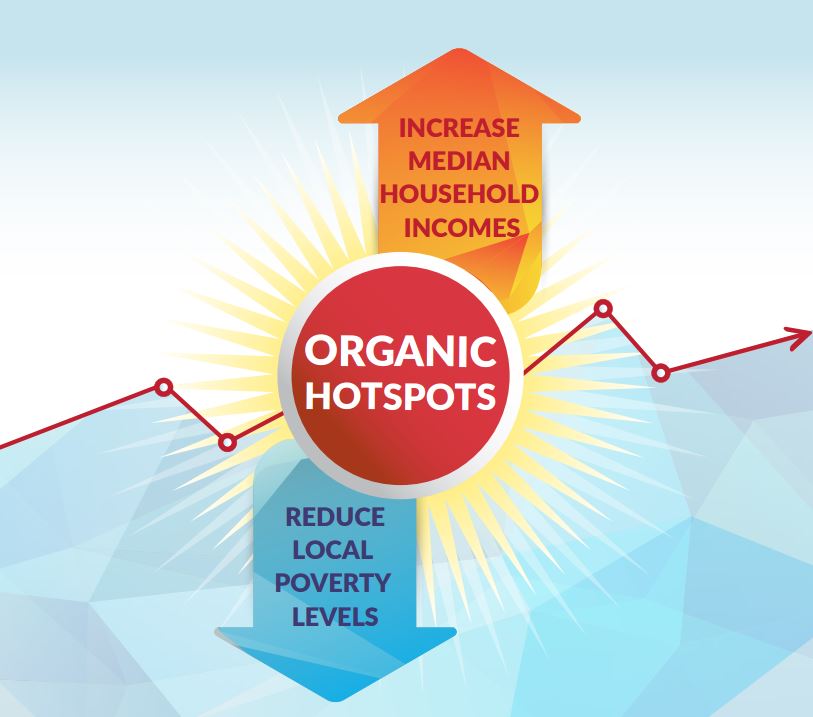 What is an organic hotspot?
What is an organic hotspot?
An organic hotspot is defined as a county with high levels of organic agricultural activity whose neighboring counties also have high organic activity.
Where are organic hotspots found?
Organic hotspots are found in 21 states throughout the nation, with the heaviest clusters on the West Coast, where a single hotspot of contiguous counties stretches from California to Washington State. Smaller hotspot clusters also appear in the northern Midwest anchored on Wisconsin, in several parts of New England and the northern Mid-Atlantic states, plus a few additional isolated areas.
How many counties have been identified as organic hotspots?
A total of 225 counties have been identified as organic economic hotspots, which equal about 7 percent of the total counties in the U.S. California leads the country in the number of organic hotspots, with 43 out of its 58 counties being identified as organic hotspots.
What causes the formation of an organic hotspot?
Outreach and knowledge transfer are critical in creating organic hotspots. The prevalence of outreach services by organic certifiers is found to play one of the strongest roles in organic hotspot formation. When at least 50% of organic operations in a county are certified by certifiers that provide outreach, the odds of that county being in an organic hotspot increase by 12.8%. Also, whether a certifier is government-sponsored, by a state department of agriculture for example, is another key factor in enabling organic hotspots. When at least 50% of organic operations in a county are certified by certifiers with a public sector home such as a state agency, the odds of that county being in an organic hotspot increase by 6.6%.
What are the economic benefits of an organic hotspot?
At the county level, organic hotspots were found to lower county poverty rates by an average of 1.3 percentage points and to raise median household incomes by an average $2,094. Per-capita income was found to be increased by an average of $899, and the unemployment rate at the county level to be lowered by 0.22 percent.
How do we know that organic activity caused the economic improvements in a county, and not that a good local economy helped boost the organic activity?
To prevent this reverse causality, the research relied on two empirical techniques: A. The technique of replacing the hotspot indicator with its prediction. This technique, along with controlling for other economic factors that affect a county’s economic health, ensures that any non-randomness is accounted for in hotspot membership selection. B. The use of time-lagged economic variables. The hotspot data is from 2009 while the economic activity data is from 2012. In addition the other economic variables are also lagged and range from 2000 to 2009. Since outcomes in 2012 cannot reasonably affect 2009 hotspots, this use of a time lag helps prevent reversal causality from affecting the estimates.
How do the economic benefits of an organic hotspot compare to the benefits of a general agricultural hotspot?
After isolating the economic impact of a county being part of a general agricultural (conventional plus organic agriculture) hotspot, the research finds that a county’s poverty rate drops by only 0.17 percentage points and the median household income increases by only $75 when the county is in a general agricultural hotspot. Also, in a general agricultural hotspot, unemployment was found to rise by 0.06 percentage points, and per capita income to decrease by $1,076. Thus organic hotspots have a much greater economic benefit at the county level than that of general agricultural hotspots.
How do the economic benefit of an organic hotspot compare to the benefits of federal antipoverty programs?
Using 2014 data, the U.S. Census finds the presence of the Supplemental Nutrition Assistant Program (SNAP) was responsible for a 1.5 percentage point reduction in the overall poverty rate, so the effects of organic economic hotspots are comparable to SNAP. The Special Supplemental Nutrition Program for Women, Infants, and Children (WIC) was found to cause a 0.1 percentage point decrease in the poverty rate, thus the impact of organic hotspots on the poverty rate is significantly greater than that of WIC.
Why do organic hotspots create these economic benefits?
The reasons for the economic benefits of organic economic hotspots were not addressed by this research, but case studies by other researchers on what drives economic improvements in local communities leads the author of this white paper to surmise that increased use of local labor by organic agriculture, a more localized supply chain for organic, and a greater emphasis on value-added crops, which command premium prices, are some of the major reasons.
What are the policy implications of the hotspot study?
This research shows that organic agriculture can be used as an economic development tool. It shows that outreach services and the transfer of knowledge play a critical role in the formation of organic hotspots. Promoting increased outreach efforts can create more organic hotspots, which in turn benefits the local economy. A focus on technical assistance, and facilitating a network of knowledge and information providers is essential to creating organic hotspots. Also, the identification of the geographic location of organic hotspot can help policy makers target specific areas to promote organic agriculture.
Did the Organic Trade Association pay for the research?
This white paper is a synthesis of three separate research papers on organic and its economic impacts. OTA did not have any role in the funding of those papers. OTA worked with the author of this white paper on its drafting, and OTA covered his travel expenses to the OTA Policy Conference at which the white paper was released.
